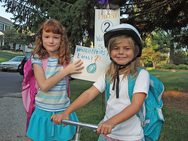Safe Routes to School benefits kids and the community

Photo by Trailnet on Flickr.
On a recent Thursday, Vienna Elementary School had only 25 cars in the kiss-and-ride when there are usually 70. This dramatic decrease reduced congestion around the school and improved the morning commute for the entire community. The students attended class but did not arrive in cars.
Today is International Walk and Bike to School Day, and more than 100 schools throughout the region are hosting events to encourage students to walk and bike to school.
Parents driving their kids to school account for 10-14 percent of morning traffic. This one day event makes a big splash and hopes that the school, students and parents will learn how easy it is to change transportation mode even a few days a week.
Reduced congestion is not the only benefit. Reports like F as in Fat have raised alarm about the growing obesity rate. Students who walk or bike to school are more physically active and have lower obesity than students who are bused or driven. Students who are physically active also enjoy better academic performance.
Vienna Elementary finds success with Safe Routes to School
Safe Routes to School programs encourage students to increase their physical activity through walking and bicycling to school. In October of 2011, Vienna Elementary School started Walking Wednesdays. 3 parent coordinators send home flyers with the students encouraging them to walk or bike to school every Wednesday. The parent coordinators give students who walk or bike a foot token or special reflector for key chains that attach to their backpacks. Parents who walk or bike with their students drink free coffee.
With to this once-a-week commitment, Vienna Elementary School has gotten results. Scott McCall, volunteer Safe Routes to School Coordinator, says the principal is reporting students are more focused in class and more students are walking and bicycling every day of the week, not just Wednesday.
Vienna Elementary has achieved half of their student population walking or bicycling in one day and regularly has 20 bikes in their racks compared to 3-4 last year.
This example contrasts with another local school. In a letter in the Washington Post, a parent at Bailey’s Elementary reported she could more easily leave Nationals ballpark on opening day than pick her child up from school.
While her family lives within a mile of the school, the streets are busy and there are no sidewalks. This makes it unsafe and infeasible for this family to walk or bike to school. The consequences are an hour-long wait to pick up her children, congested roads, and a missed opportunity for physical activity.
The difference between the schools is that Vienna Elementary not only has adequate sidewalk infrastructure and is directly adjacent to the W&OD trail, but the Safe Routes to School program makes it fun to for students to walk and bicycle to school.
Infrastructure is a big hurdle for walking and bicycling to school and in communities. Retrofitting existing communities is expensive and built out communities sometimes have little room in the right-of-way for sidewalks and bike lanes. It is not only about how communities spend their money but also about the policies in place that make our transportation system inclusive of pedestrians and cyclists.
Complete Streets policies make streets work for all users
One policy that can prevent further disregard for pedestrians and bicyclists is Complete Streets. Complete Streets policies ensure that streets are designed, maintained and operated for all users of the road—pedestrians, bicyclists, persons using wheelchairs, older adults and children. Infrastructure improvements will still take time, but the policy ensures the local transportation agency works to accommodate all users within a network throughout the community.
The National Capital Region Transportation Planning Board (TPB) adopted a regional Complete Streets policy in May. The TPB policy encourages all local jurisdictions to adopt their own policies and commit to multi-modal transportation planning. This is an opportunity for local jurisdictions to commit to easier morning commutes and happy children safely walking and bicycling to school.
Vienna Elementary School shows the huge benefits from the right infrastructure and a little effort. The transportation culture of a school changes. Most likely, now that the trip to school has changed, families are changing their mode of travel for other trips such as to the library or grocery store.
The Greater Washington Region Safe Routes to School Network is posting photos and stories from International Walk and Bike to School Day on their website. It will feature an award ceremony for the Takoma Park Safe Routes to School program, which recently won national recognition.
If you are still not convinced that Safe Routes to School is a solution, look at the kids’ faces. They do not know they are reducing congestion or receiving health benefits. They are just really happy to be outside with their friends on their way to school.
